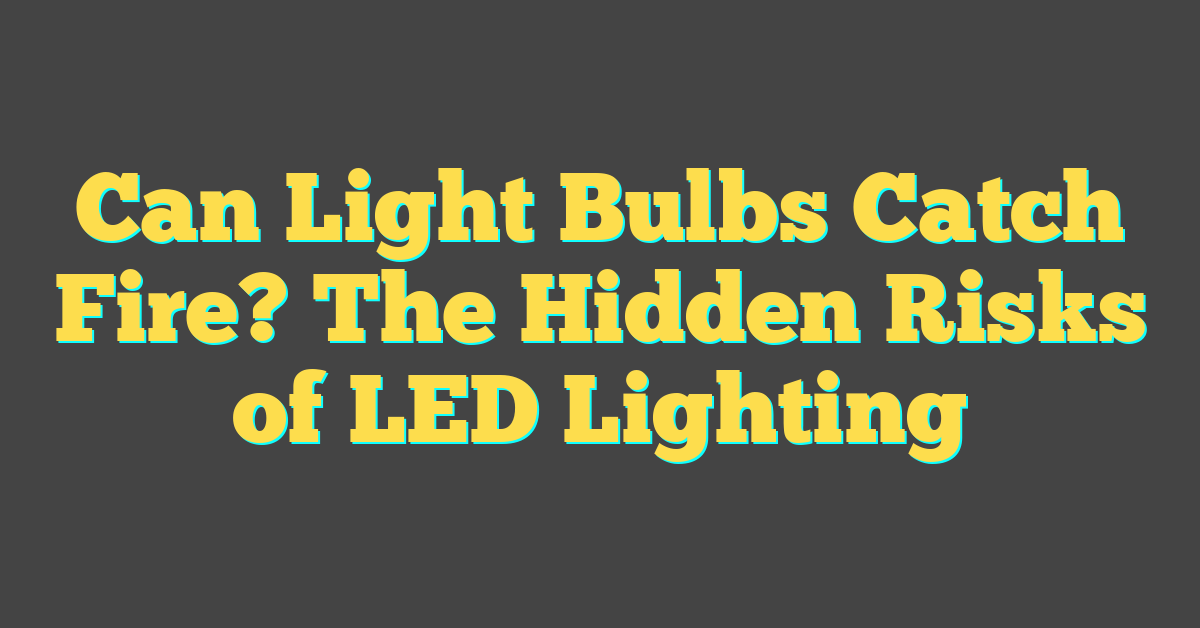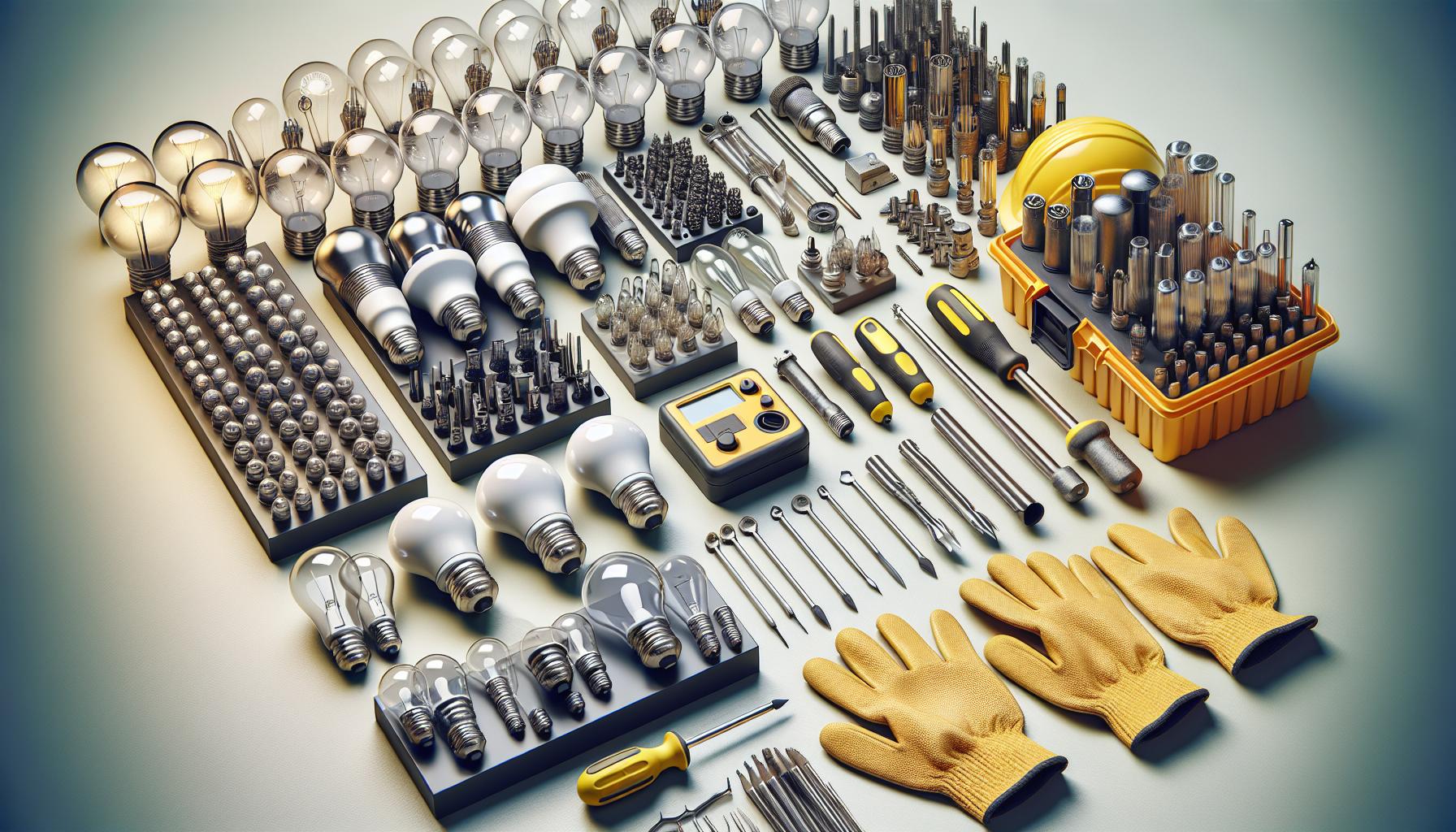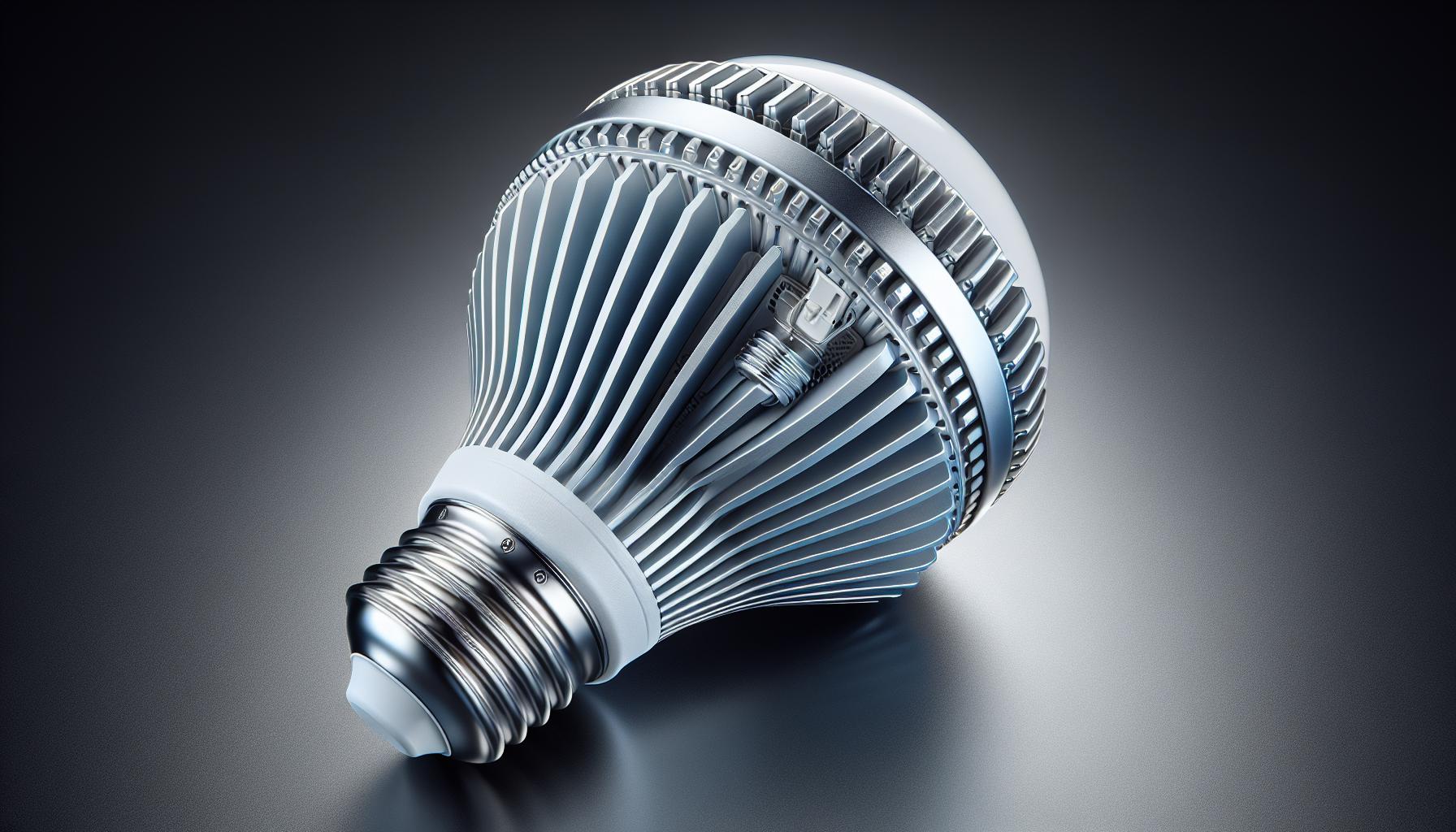Ever wondered if those little beacons of light in your home could turn into fire starters? You’re not alone. It’s a question that flickers in the minds of many homeowners and renters alike. Let’s shed some light on the matter.

While modern lighting has come a long way in terms of safety and efficiency, the risk of a light bulb catching fire isn’t entirely out of the question. It’s all about understanding what factors contribute to such a hazard.
Causes of Light Bulbs Catching Fire
When you’re brightening your space, the last thing you want is a lighting mishap. Yet occasionally, light bulbs can become more than just fixtures in your home; they can pose a risk. Understanding why light bulbs may catch fire helps you maintain a safe and cozy environment.
Key factors that contribute to these fiery incidents usually stem from:
- Overheating: Bulbs can give off heat, and if they’re enclosed in a tight fixture without proper ventilation, they can get too hot. Look for warning signs like discolored sockets or scorch marks.
- Electrical Issues: Faulty wiring or loose connections can cause sparks that may ignite. Regularly check the wiring in your home, especially if it’s older.
- Incompatible Wattage: Using a bulb with a higher wattage than the fixture’s recommendation may lead to overheating. Stick to the guidelines listed on your lighting fixtures.
Also, consider that different types of bulbs have different risk levels:
- Incandescent Bulbs: These can run quite hot and are more likely to overheat, especially in small or enclosed spaces.
- LEDs: They are less prone to catching fire as they operate at a cooler temperature, but they’re not immune, especially if there’s an electrical issue.
- Compact Fluorescent Lamps (CFLs): These bulbs contain a small amount of mercury, so while fire risk is lower, they come with their own set of safety considerations.
Here are a few things you can do to minimize risks:
- Ensure light fixtures are clean and dust-free.
- Always use the correct bulb wattage.
- Replace damaged cords and follow proper installation techniques.
By keeping an eye out for these warning signs and staying knowledgeable about your lighting choices, you’ll keep your home both beautifully lit and hazard-free.
Remember, your vigilance can be your home’s best defense against accidental fires. Keep those DIY skills sharp and stay illuminated about potential risks, ensuring your home projects are not only creative but safe.
Types of Light Bulbs Prone to Fire Hazards

If you’re a DIY enthusiast or simply love to keep your space well-lit, you might have wondered about the safety profiles of different light bulbs. Not all bulbs are created equal and some are more prone to fire hazards than others. It’s important to know which can offer beauty without compromising on safety.
Incandescent bulbs are an old favorite but they operate at higher temperatures. This trait makes them more likely to overheat especially in poor ventilation or when in contact with flammable materials. They’re not only inefficient when it comes to energy consumption but also have a higher fire risk.
Next in line are halogen bulbs, known for their bright, white light. They run hotter than incandescent bulbs and even small spikes in current can lead to overheating. If halogens are your go-to choice, ensure they are well seated in their fixtures and away from anything that could ignite.
Compact Fluorescent Lamps (CFLs), while more energy-efficient than incandescents and halogens, come with their own set of risks. If a CFL’s plastic base becomes discolored, it’s a sign that the bulb might be too hot and could potentially melt surrounding fixtures, leading to a fire.
LEDs are the frontrunners in terms of safety, longevity, and energy efficiency. However, they’re not completely immune to fire risks. Low-quality or improperly installed LED bulbs can still pose a hazard. Always opt for reputable brands and ensure they’re compatible with your fixtures.
Here’s a brief overview of the relative fire risk associated with each type of bulb:
| Bulb Type | Heat Emission | Fire Risk |
|---|---|---|
| Incandescent | High | High |
| Halogen | Very High | High |
| CFLs | Moderate to High | Moderate |
| LEDs | Low | Low |
« Can Light Bulbs Be Stored in Garage? Ultimate Guide to Safeguarding Your Bulbs
Can Light Bulbs Explode? Tips to Prevent Unexpected Shatters »
To keep your living space safe, always pair the right type of bulb with suitable fixtures and follow the manufacturer’s guidelines. Regular inspections and maintenance go a long way in preventing any fire hazards. Remember, it’s not just about lighting up your home; it’s about doing so safely.
Warning Signs of a Potentially Dangerous Light Bulb

Staying vigilant about the condition of your light bulbs can help prevent potential fire hazards in your home. Over time, wear and tear on any bulb can create risks, but there are certain warning signs you can spot. It’s crucial to note these signs to ensure your home stays safe and illuminated without incident.
Firstly, if you notice that a bulb is flickering consistently, it might be more than just an annoyance—it could signal an electrical fault. Flickering often indicates loose connections or aged wiring and if left unchecked, it can overheat. Make it a habit to investigate any flickering bulbs and address the root cause quickly.
Another red flag is a bulb that’s hot to the touch. As you know, incandescent and halogen bulbs normally run hotter than LEDs or CFLs. However, if you find that a bulb is emitting excessive heat, it could be the wrong type for the fixture or the wattage might be too high for its intended use.
Discoloration or melting plastic around the bulb’s base, especially in CFLs, is a tell-tale sign that something’s amiss. This usually happens when the plastic exceeds its thermal endurance which, needless to say, can lead to a fire if you don’t act swiftly.
Smelling an acrid burning odor near a light fixture isn’t something to ignore. This smell might be the result of a bulb that’s overheating and should be considered a serious warning that requires immediate attention.
On a less dire note, incompatible dimmer switches can also cause problems, leading to shortened bulb lifespan or overheating. Ensure your bulbs match the specifications for their application.
Lastly, if you notice any charring or smoke marks around your fixture, this is an urgent indicator of a potential fire hazard. Shut off the power to the fixture immediately and inspect for any damage.
Keep an eye out for these indicators, it’s better to be proactive about your and your family’s safety. Regular bulb inspections and maintenance become second nature, just like any home DIY project you’d invest your heart and efforts in. After all, the lights in your home are more than just functional; they’re part of your abode’s comfort and ambiance.
Safety Measures to Prevent Light Bulbs from Catching Fire

Safety should always be your top priority when dealing with light fixtures in your home. Since you’re already familiar with the looming danger that faulty bulbs present, it’s time to talk about proactive steps to prevent these hazards.
Regular Maintenance is a game-changer. Inspect your light fixtures and bulbs periodically for any signs of damage or wear. It’s not just about watching out for the warning signs mentioned earlier, but also about keeping an eye on the bulb’s performance. If it’s not shining as bright as it used to or it’s showing any anomaly, consider replacing it.
When choosing light bulbs, ensure they are Properly Rated for Their Fixtures. The wattage of your bulb should match the rating of the fixture. If a bulb requires more power than the fixture can provide, this mismatch can lead to overheating and potentially, a fire. Always check the lamp or fixture for a wattage rating, and follow it to the letter.
Invest in Quality Light Bulbs from reputable brands. They are less likely to have manufacturing defects that could cause them to overheat. Remember, quality doesn’t always mean expensive; it means reliable and well-reviewed by other DIY enthusiasts and experts alike.
Make sure your fixtures are Clean and Free of Dust. Accumulated dust and dirt can insulate the heat, leading to higher temperatures that bulbs aren’t designed to handle. So, giving your fixtures a gentle clean every now and then is not just good for hygiene but also for safety.
For any advanced lighting systems or smart bulbs, always ensure they are Compatible With Your Home’s Wiring and Devices. If you’re unsure about compatibility, especially with dimmer switches, it’s best to consult with a professional electrician. They can guide you through installations that won’t just enhance your home’s ambiance but maintain safety as well.
Using these preventative measures can drastically reduce the risk of light bulbs catching fire. While enjoying the warm glow of your home’s lighting, you’ll also appreciate the peace of mind that comes with knowing you’ve taken the necessary steps to protect your space.
Myth Busted: Can LED Light Bulbs Catch Fire?

You’ve probably heard a tale or two about light bulbs catching fire, sparking unease every time you flip the switch. Let’s shed some light on LED bulbs and their safety.
LED bulbs are touted for their energy efficiency and long lifespan, but does their cool operation mean they’re immune to fire hazards? The truth is, while they are designed to be much safer than their incandescent or halogen counterparts, they’re not entirely risk-free. The main culprit in LED bulb fire risks lies in the electrical components, not in the LED itself.
When you’re knee-deep in your weekend DIY lighting projects, pay attention to the quality of the LED bulbs you’re installing. Quality matters, as poor manufacturing can lead to overheating. This is particularly true for the transformer, often housed within the bulb casing in low-voltage LEDs, which can overheat if it’s not up to par.
Bear in mind these essential points about LED bulbs:
- They produce less heat than other bulbs, making them less prone to overheating.
- Overheating may occur due to faulty wiring, bad connections, or incompatible dimmer switches.
- High-quality LED bulbs are equipped with heat sinks to manage heat dissipation.
Safety goes beyond selecting the right bulb. You’ve got to make sure your fixtures are fit for the task. A well-ventilated light fixture is key to preventing overheating, as it allows for proper airflow around the bulb. Check that your fixtures are designed for LED compatibility, which can make a world of difference in safety and functionality.
When an LED bulb is kept in an enclosed fixture without proper ventilation, the minimal heat they do produce can accumulate, leading to potential risks. So it’s not just about opting for LEDs but also about ensuring that they’re used in appropriate fixtures.
As you continue to enlighten your home with various lighting choices, always prioritize safety. Opt for quality LEDs from reputable brands, be diligent with installation, and perform routine checks on your light fixtures. These simple habits help keep your lights shining bright and your home safe from unwanted sparks.
Conclusion
So you’ve got the lowdown on LED light bulbs and their fire safety. Remember that while they’re safer than other types, they’re not foolproof. You’ll want to invest in quality LEDs and pair them with the right fixtures to minimize any risk. Keep an eye on proper ventilation, and you’ll be setting the stage for a safer, brighter home. Stay illuminated and stay safe!
Frequently Asked Questions
Are LED light bulbs safe to use?
LED light bulbs are generally safe and pose less risk of fire than incandescent or halogen bulbs. However, they are not entirely risk-free, and safety precautions should still be taken.
Can LED light bulbs catch fire?
While the risk is low, LED bulbs can catch fire, primarily due to the overheating of electrical components such as the transformer, especially in poorly manufactured bulbs.
What causes LED light bulbs to overheat?
LED bulbs may overheat due to poor manufacturing quality, inadequate fixtures that do not provide enough ventilation, or incompatible designs not meant for LED use.
How can I prevent LED bulbs from overheating?
To prevent LED bulbs from overheating, choose high-quality bulbs from reputable manufacturers, ensure proper fixture ventilation, and use fittings specifically designed for LED compatibility.
What should I look for when buying LED bulbs?
When purchasing LED bulbs, look for high-quality products with positive reviews, certifications of safety standards, and make sure they’re appropriate for your fixture types.




